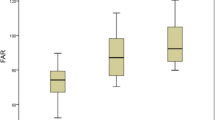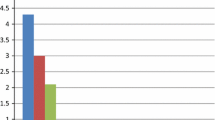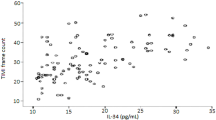Summary
Background
A number of inflammatory markers such as high-sensitivity C-reactive protein (Hs-CRP), interleukin-6 (IL-6), and fibrinogen have been shown to be associated with coronary slow flow (CSF). Our aim was to investigate the relationship between albumin, a long-acting negative acute-phase protein, and CSF.
Methods
A total of 106 patients with angiographically proven slow coronary flow and 57 control subjects with normal coronary flow were included in the study. Serum levels of Hs-CRP and albumin were measured. CSF was defined by Thrombolysis In Myocardial Infarction (TIMI) frame count (TFC) method.
Results
Serum albumin (s-albumin) was significantly lower in the CSF group (3.79 ± 0.3 vs 4.17 ± 0.3, p < 0.001), whereas Hs-CRP level was significantly higher in the CSF group compared with the controls (1.22 ± 0.79 vs 0.76 ± 0.44, p < 0.001). S-albumin and Hs-CRP were correlated with the mean TFC in the whole study population (r= − 0.574, p < 0.001; r = 0.376, p < 0.001, respectively). Hs-CRP and low s-albumin were found to be significant predictors of CSF in the multivariate analysis. The comparison of receiver-operating characteristics curves for s-albumin and Hs-CRP demonstrated that s-albumin was the strongest predictor of CSF.
Conclusions
We found that s-albumin levels decreased and Hs-CRP levels increased in patients with CSF. S-albumin was also found to have superior predictive value than Hs-CRP for diagnosing CSF. S-albumin, an inexpensive and easily measurable laboratory variable, may be a useful predictor of CSF, especially when other reasons which alter its serum levels were excluded.
Zusammenfassung
Grundlagen
Von mehreren Entzündungsmarkern, wie hochsensitivem C-reaktiven Protein (hs-CRP), Interleukin-6 (IL-6) und Fibrinogen konnte gezeigt werden, dass sie mit langsamem koronarem Durchfluss („coronary slow flow“, CSF) vergesellschaftet sind. Ziel unserer Studie war es, zu prüfen, ob ein Zusammenhang zwischen Albumin, einem lang-wirksamen negativen Akutphasenprotein und CSF besteht.
Methodik
Insgesamt wurden 106 Patienten mit angiographisch nachgewiesenem CSF und 57 Kontrollen mit normalem Koronarfluss in die Studie aufgenommen. Die Serumkonzentrationen von hs-CRP und Albumin wurden gemessen. CSF wurde durch die TIMI (Thrombolysis In Myocardial Infarction) Frame Count (TFC) Methode erhoben.
Ergebnisse
Das Serum Albumin war in der Gruppe mit CSF im Vergleich zur Kontrolle signifikant erniedrigt (3,79 ± 0,3 vs 4,17 ± 0,3, p < 0,001) – die hs-CRP Konzentrationen dahingegen signifikant erhöht (1,22 ± 0,79 vs 0,76 ± 0,44, p < 0,001). Serum Albumin und hs-CRP waren in der Gesamtpopulation mit dem mittleren TFC korrelieret (r= − 0,574, p < 0,001; r = 0,376, p < 0,001, respektive). In der Multivarianzanalyse zeigte sich, dass hs-CRP und niedriges Serum Albumin signifikante Prädiktoren eines CSF sind. Der Vergleich der ROC Analysen für hs CRP und Serum Albumin ergab, dass das Serum Albumin der stärkste Prädiktor eines CSF war.
Schlussfolgerungen
Bei unseren Patienten mit CSF waren die Serum Albumin-Konzentrationen erniedrigt und die hs-CRP Werte erhöht. Das Serum Albumin war in unseren Händen der bessere Prädiktor als das hs-CRP für einen CSF. Serum Albumin ist ein billiger und leicht messbarer Laborparameter, der – nach Ausschluss anderer Albumin beeinflussender Faktoren - ein nützlicher Prädiktor für einen CSF sein kann.

Similar content being viewed by others
References
Sezgin AT, Sıg˘ırcı A, Barutcu I, et al. Vascular endothelial function in patients with slow coronary flow. Coron Artery Dis. 2003;14:155–61.
Mosseri M, Yarom R, Gotsman MS, Hasin Y. Histologic evidence for small-vessel coronary artery disease in patients with angina pectorisand patent large coronary arteries. Circulation. 1986;74:964–72.
Pekdemir H, Cin VG, Cicek D, et al. Slow coronary flow may be a sign of diffuse atherosclerosis. Contribution of FFR and IVUS. Acta Cardiol. 2004;59:127–33.
Cutri N, Zeitz C, Kucia AM, et al. ST/T wave changes during acute coronary syndrome presentation in patients with the coronary slow flow phenomenon. Int J Cardiol. 2011;146:457–8.
Horjeti B, Goda A. Acute ischemia manifestation in a patient with coronary slow flow phenomenon. J Electrocardiol. 2012;45:277–9.
Wozakowska-Kaplon B, Niedziela J, Krzyzak P, et al. Clinical manifestations of slow coronary flow from acute coronary syndrome to serious arrhythmias. Cardiol J. 2009;16:462–8.
Saya S, Hennebry TA, Lozano P, et al. Coronary slow flow phenomenon and risk for sudden cardiac death due to ventricular arrhythmias: a case report and review of literature. Clin Cardiol. 2008;31:352–5.
Halliwell B. Albumin-an important extracellular antioxidant? Biochem Pharmacol. 1988;37:569–71.
Danesh J, Collins R, Appleby P, et al. Association of fibrinogen, C-reactive protein, albumin, or leukocyte count with coronary heart disease: meta-analyses of prospective studies. JAMA. 1998;279:1477–82.
Kuller LH, Eichner JE, Orchard TJ, et al. The relation between serum albumin levels and risk of coronary heart disease in the multiple risk factor intervention trial. Am J Epidemiol. 1991;134:1266–77.
Gillum RF, Ingram DD, Makuc DM. Relation between serum albumin concentration and stroke incidence and death: the NHANES I epidemiologic follow-up study. Am J Epidemiol. 1994;140:876–88.
Gibson CM, Cannon CP, Daley WL, et al. TIMI frame count: a quantitative method of assessing coronary artery flow. Circulation. 1996;93:879–88.
Singh S, Kothari SS, Bahl VK. Coronary slow flow phenomenon: an angiographic curiosity. Indian Heart J. 2004;56:613–7.
Gokce M, Kaplan S, Tekelioglu Y, Erdogan T, Kucukosmanoglu M. Platelet function disorder in patients with coronary slow flow. Clin Cardiol. 2005;28:145–8.
Libby P, Ridker PM, Maseri A. Inflammation and atherosclerosis. Circulation. 2002;105:1135–43.
Li JJ, Qin XW, Li ZC, et al. Increased plasma C-reactive protein and interleukin-6 concentrations in patients with slow coronary flow. Clin Chim Acta. 2007;385:43–7.
Madak N, Nazlı Y, Mergen H, et al. Acute phase reactants in patients with coronary slow flow phenomenon. Anadolu Kardiyol Derg. 2010;10:416–20.
Varol E, Gülcan M, Aylak F, et al. Increased neopterin levels and its association with angiographic variables in patients with slow coronary flow: an observational study. Anadolu Kardiyol Derg. 2011;11:692–7.
Arı H, Arı S, Erdog˘an E, et al. The effects of endothelial dysfunction and inflammation on slow coronary flow. Turk Kardiyol Dern Ars. 2010;38:327–33.
Turhan H, Saydam GS, Erbay AR, et al. Increased plasma soluble adhesion molecules; ICAM-1, VCAM-1, and E-selectin levels in patients with slow coronary flow. Int J Cardiol. 2006;108:224–30.
Kushner I. The phenomenon of the acute phase response. Ann N Y Acad Sci. 1982;389:39–48.
Pepys MB, Baltz ML. Acute phase proteins with special reference to C-reactive protein and related proteins (pentaxins) and serum amyloid A protein. Adv Immunol. 1983;34:141–212.
Ritchie RF, Palomaki GE, Neveux LM, Navolotskaia O, Ledue TB, Craig WY. Reference distributions for the negative acute-phase serum proteins, albumin, transferrin and transthyretin: a practical, simple and clinically relevant approach in a large cohort. J Clin Lab Anal. 1999;13:273–9.
Nelson JJ, Liao D, Sharrett AR, et al. Serum albumin level as a predictor of incident coronary heart disease: the Atherosclerosis Risk in Communities (ARIC) study. Am J Epidemiol. 2000;151:468–77.
Grimble R. Serum albumin and mortality [Letter]. The Lancet. 1990;335:350.
Doweiko JP, Bistrian BR. The effect of glycosylated albumin on platelet aggregation. J Parenter Enteral Nutr. 1994;18:516–20.
Halliwell B. Albumin-an important extracellular antioxidant? Biochem Pharmacol. 1988;37:569–71.
Krijgsman B, Papadakis JA, Ganotakis ES, Mikhailidis DP, Hamilton G. The effect of peripheral vascular disease on the serum levels of natural anti-oxidants: bilirubin and albumin. Int Angiol. 2002;21:44–52.
Djoussé L, Rothman KJ, Cupples LA, Levy D, Ellison RC. Serum albumin and risk of myocardial infarction and all-cause mortality in the Framingham Offspring study. Circulation. 2002;106:2919–24.
Koç F, Erdem S, Altunkas¸ F, et al. Ischemia-modified albumin and total antioxidant status in patients with slow coronary flow: a pilot observational study. Anadolu Kardiyol Derg. 2011;11:582–7.
Selcuk H, Maden O, Selcuk MT, Celenk MK, Geyik B, Tufekcioglu O. Documentation of impaired coronary blood flow in chronic obstructive pulmonary disease patients. Circ J. 2010;74:346–52.
Conflict of interest
All authors declared that there is no conflict of interest.
Author information
Authors and Affiliations
Corresponding author
Rights and permissions
About this article
Cite this article
Cetin, M., Zencir, C., Tasolar, H. et al. The association of serum albumin with coronary slow flow. Wien Klin Wochenschr 126, 468–473 (2014). https://doi.org/10.1007/s00508-014-0559-8
Received:
Accepted:
Published:
Issue Date:
DOI: https://doi.org/10.1007/s00508-014-0559-8




